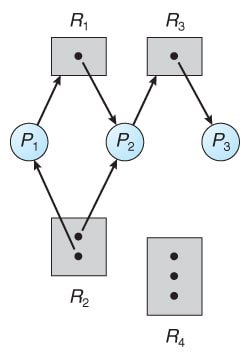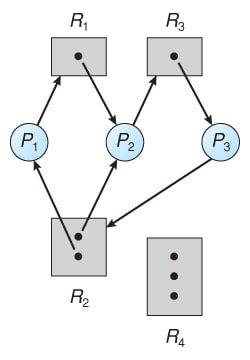OS 7.01 - Deadlock
Deadlock
Deadlock occurs in a set of processes when every process in the set is waiting for an event that can only be caused by another process in the set.
A deadlock occurs in a multiprogramming environment when two or more processes are permanently blocked because each is waiting for a resource held by another process. As a result, none of the processes can proceed, causing a system halt.
In a deadlock, processes never finish executing, and system resources are tied up, preventing other jobs from starting.
Example:
- Consider two processes, P1 and P2, and two resources, R1 and R2:
- P1 holds R1 and is waiting for R2.
- P2 holds R2 and is waiting for R1.
- Neither process can proceed because they are both waiting for each other to release the required resource. This creates a circular wait, which is one of the necessary conditions for a deadlock to occur.
Deadlock Characterization
Deadlock occurs when two or more processes are permanently blocked, with each process waiting for a resource held by another process. Preventing, detecting, and handling deadlocks are crucial in multiprogramming systems.
1. Necessary Conditions for Deadlock:
Deadlock can occur only if all four of the following conditions hold simultaneously:
Mutual Exclusion: Resources cannot be shared. At least one resource must be held in a nonsharable mode; that is, only one process at a time can use the resource. If another process requests that resource, the requesting process must be delayed until the resource has been released.
Hold and Wait: Processes holding resources can wait for other resources. A process must be holding at least one resource and waiting to acquire additional resources that are currently being held by other processes.
No Preemption: Resources cannot be forcibly taken from a process. Resources cannot be preempted; that is, a resource can be released only voluntarily by the process holding it, after that process has completed its task.
Circular Wait: A closed chain of processes exists, where each process holds a resource that the next process in the chain is waiting for. A set {P0 , P1 , …, Pn } of waiting processes must exist such that P0 is waiting for a resource held by P1 , P1 is waiting for a resource held by P2 , …, Pn−1 is waiting for a resource held by Pn , and Pn is waiting for a resource held by P0 .
2. Resource Allocation Graph (RAG)
A Resource Allocation Graph (RAG) is a directed graph used to represent the allocation of resources in a system. It helps in detecting deadlocks by visualizing the relationships between processes and resources, making it easier to identify potential deadlock conditions.
The RAG is represented as G = (V, E), where:
Vis the set of vertices (nodes), andEis the set of edges (connections between vertices).
Components of RAG:
- Vertices (V):
- Processes: Represented as circles (e.g., P1, P2, …, Pn).
- Resources: Represented as rectangles (e.g., R1, R2, …, Rm).
- Edges (E):
- Request Edge (Pi → Rj): A directed edge from process Pi to resource Rj, indicating that Pi is waiting for Rj.
- Assignment Edge (Rj → Pi): A directed edge from resource Rj to process Pi, indicating that Rj is allocated to Pi.
Example Resource Allocation Graph:
Consider a system with the following processes and resources:
- Processes:
P = {P1, P2, P3} - Resources:
R = {R1, R2, R3, R4}
Set of edges (process-resource dependencies):
P1 → R1(P1 requests R1)P2 → R3(P2 requests R3)R1 → P2(R1 is allocated to P2)R2 → P2(R2 is allocated to P2)R2 → P1(R2 is allocated to P1)R3 → P3(R3 is allocated to P3)
Resource instances:
- One instance of resource type R1
- Two instances of resource type R2
- One instance of resource type R3
- Three instances of resource type R4
Process states:
- P1 is holding an instance of resource R2 and is waiting for an instance of resource R1.
- P2 is holding an instance of R1 and an instance of R2 and is waiting for an instance of R3.
- P3 is holding an instance of R3.
This system could potentially lead to a deadlock if processes are unable to obtain the resources they are waiting for.
Deadlock Detection Using RAG

A deadlock occurs when a cycle is present in the Resource Allocation Graph (RAG).
- If the graph contains no cycles, no process is deadlocked.
- If a cycle exists, a deadlock may be present.

If each resource type has exactly one instance, then a cycle implies that a deadlock has occurred.
If each resource type has several instances, then a cycle does not necessarily imply that a deadlock has occurred. In this case, a cycle in the graph is a necessary but not a sufficient condition for the existence of deadlock.